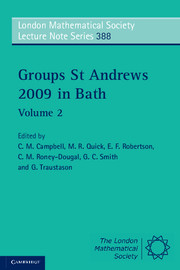Book contents
- Frontmatter
- Contents
- Introduction
- Algorithms for matrix groups
- Residual properties of 1-relator groups
- Words and groups
- The modular isomorphism problem for the groups of order 512
- Recent progress in the symmetric generation of groups
- Discriminating groups: a comprehensive overview
- Extending the Kegel Wielandt theorem through π-decomposable groups
- On the prime graph of a finite group
- Applications of Lie rings with finite cyclic grading
- Pronormal subgroups and transitivity of some subgroup properties
- On Engel and positive laws
- Maximal subgroups of odd index in finite groups with simple classical socle
- Some classic and nearly classic problems on varieties of groups
- Generalizations of the Sylow theorem
- Engel groups
- Lie methods in Engel groups
- On the degree of commutativity of p-groups of maximal class
- Class preserving automorphisms of finite p-groups: a survey
- Symmetric colorings of finite groups
- References
On the prime graph of a finite group
Published online by Cambridge University Press: 05 July 2011
- Frontmatter
- Contents
- Introduction
- Algorithms for matrix groups
- Residual properties of 1-relator groups
- Words and groups
- The modular isomorphism problem for the groups of order 512
- Recent progress in the symmetric generation of groups
- Discriminating groups: a comprehensive overview
- Extending the Kegel Wielandt theorem through π-decomposable groups
- On the prime graph of a finite group
- Applications of Lie rings with finite cyclic grading
- Pronormal subgroups and transitivity of some subgroup properties
- On Engel and positive laws
- Maximal subgroups of odd index in finite groups with simple classical socle
- Some classic and nearly classic problems on varieties of groups
- Generalizations of the Sylow theorem
- Engel groups
- Lie methods in Engel groups
- On the degree of commutativity of p-groups of maximal class
- Class preserving automorphisms of finite p-groups: a survey
- Symmetric colorings of finite groups
- References
Summary
Abstract
Let G be a finite group. The prime graph Г(G) of G is defined as follows. The vertices of Г(G) are the primes dividing the order of G and two distinct vertices p, p′ are joined by an edge if there is an element in G of order pp′. In this paper we give a survey about the question of which groups have the same prime graph. It is proved that some finite groups are uniquely determined by their prime graph. Applications of this result to the problem of recognition of finite groups by the set of element orders are also considered.
Introduction
If n is an integer, then we denote by π(n) the set of all prime divisors of n. If G is a finite group, then the set π(|G|) is denoted by π(G). Also the set of order elements of G is denoted by πe(G). Obviously πe(G) is partially ordered by divisibility. Therefore it is uniquely determined by μ(G), the subset of its maximal elements. We construct the prime graph of G as follows:
Definition 1.1The prime graph Г(G) of a group G is the graph whose vertex set is π(G), and two distinct primes p and q are joined by an edge (we write p ~ q) if and only if G contains an element of order pq. Let t(G) be the number of connected components of Г(G) and let π1(G), π2(G), …, πt(G)(G) be the connected components of Г(G).
- Type
- Chapter
- Information
- Groups St Andrews 2009 in Bath , pp. 424 - 428Publisher: Cambridge University PressPrint publication year: 2011
References
- 3
- Cited by



